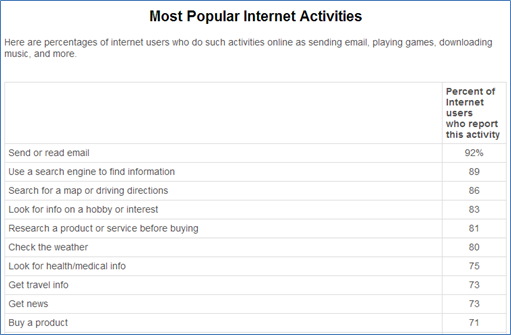
Studies show that the average American consumer goes through an average of 100,000 digital words each day. Among these consumers, 92% say that they prefer and would internalize the meaning of these words if they were delivered to them in story form. If you want to reach out to these consumers, then you should have something more interesting to say than just mere words and lines of content.
Each individual or business entity has their own stories to tell, each story born from out of the experiences they gained over the years and how it affected the people they have interacted with throughout their existence. How well you can tell these stories can make you or your business stand out from the rest and give you a much need advantage over your competitors.
Telling and hearing stories is a natural thing for people. This is the power of storytelling. It would definitely bring more favorable results for your overall digital marketing campaign if you can successfully weave the power of storytelling into your content marketing campaign. Grow your business and boost your digital marketing campaign now with storytelling.
Creating Your Brand Story
Before you can start using storytelling on your content marketing you need to create your own brand story. Your story is all about what your brand is and what it can do – it is why your brand exist. Your brand story involves not only the people, ideas and other information about your brand, but it also tells people why they need your brand and how it can make their lives better. The following are important elements that make up a great brand story.
Your Brand’s Reason For Being
One of the core messages in your brand story is your company or business’ reason for existence. It tells why your brand is important for people and what aspects sets it apart or above the rest of your competition. But before you can even establish this, you and the rest of your company should have a clear understanding of the foundations behind your business – your goals, mission, vision and core strategies.
Your Brand’s History
The historical perspectives of how your brand came to be can make up a good story. This is particularly true if there was something historical, creative or simply profound in how your brand and business was brought into existence. Get inspirations from the viral stories of other brands and study how they have embedded the historical perspective of their existence into their story.
Your Brand’s Main Characters
Online audiences usually look for characters that they can root for (or in some cases, go against) when reading a brand story. That’s what Susan Gurnelius from Forbes wrote in her article. Your character should represent the people that is in the heart of your brand or business, an embodiment of your company ideals – and these should be consistent in the stories you tell across various content platforms.
Your Brand’s Mission
Your brand’s mission is the reason why you’re in business at all, and this should be clearly integrated into your story. It should include the problems or issues that your brand and business is trying to address or solve and how you are moving or responding towards this call.
Your Brand’s Values
Studies show that relationships between a consumer and a brand develop 13% of the time because of the interactions that occur between them. A study by the Harvard Business Review however stated that if companies integrated their brand values into their stories, interactions and conversations can then be more effective in connecting the brand with consumers.
Your Brand’s Failures
People love how one can struggle and overcome failures and pitfalls and come out victorious in the end. People will have a deeper and more personal connection with your brand as they can easily identify with failure-success stories like these.
Story Types You Can Create
Using storytelling as an integral part of your content marketing strategy, you need to create stories that are compelling, thought-provoking, something that would pique the interest of your targeted audiences. The following are story types that you can create and use for a strong content marketing campaign.
Stories That Teach
If you’d look closely at the table below, 8 out of these top 10 most popular activities online can be generally classified as looking for information. With this in mind, craft your stories to be educational, teach something or provide solutions to a problem that your targeted audiences would like to know.

Stories That are Trending
Trending news is a surefire way of grabbing targeted readers’ attention and entice them to read your content, your story. Craft your story based on trending news and how these stories relate to your brand, your industry or niche, or how these news stories can affect users of your brand and products.
Stories About Your Clients
Going into business means dealing with various types of clients, each of them with their own stories to tell. It would be to your best interest to develop relationships with clients with inspiring success stories that you can use or integrate within your own storytelling campaign. Of course, you need to get their permissions first and confirm if they want to remain anonymous as you tell their stories.
Stories that Include Classic Lessons, Quotes and Narratives
You’ll never get wrong with the classics – quotes, lessons and narratives – as long as the message they convey would fit right within the story you are trying to tell. You can re-tell these classics in a context that would be interesting to your targeted audiences and relevant to your brand or business. Just make sure you give proper credit to the source of your stories.
Stories that are Personal
Personal stories are some of the most powerful storytelling formulas you can include in your content marketing campaign. It is through the telling of your life experiences, your struggles, and victories as related to your brand or niche that you get to develop a more personal level of relationship and trust with your customers.
Telling Your Brand Story – and Go Viral
Now that you have your story, it’s time to tell it to your targeted audiences. There are certain considerations however when you tell your story to make them even more interesting and palatable to your targeted audiences in a bid to make them more viral and reach even more audiences.
Stick to the Basics
When you tell your story it would be best not to complicate things and just stick to the basics and essentials as discussed earlier. Each important element should be present as well as the basic flow of introduction, peaks, valleys and conclusion should be clearly laid out for the clear understanding and satisfaction of your targeted audiences.
Embed Strong Positive Emotions
People share stories that present strong positive emotions more than traditional news stories (which usually focus on negative emotions). They do so as they can clearly identify themselves with these emotions strong enough for them to want others to feel these emotions too. When you tell your story through your content, make sure that you embed such strong emotions in the message you are trying to convey.
Make Use of Different Channels
Content marketing comes in various types and forms and you can make use of all these channels in your storytelling campaign based on how applicable they are with your story. Your website is your main channel where your story is to be told, but you can use of other digital marketing channel available like blogs, social networks, article sharing sites, as a guest content provider in other blogs and sites, and video presentations.
Make Use of Pictures and Graphics
The chart below highlights pictures as the most widely shared type of content on social media sites. People are visual beings so it is no wonder that most will be more attracted to stories with visual elements embedded that can help them imagine or visualize the message you want to convey through storytelling.

Make Use of Videos
While graphics and pictures can boost the interest factor in your stories, adding videos can boost it even more. In fact, you can get as much as 12x more chances for your stories to be liked and shared on social media if you incorporate video elements. Not only will it create higher interest, it will also generate more interactions between your brand and your audience.
Be Honest
Honesty is the best policy, so they say, but it is still very applicable now as it did ages past. Susan Gurnelius from Forbes believe that you can be more effective in your brand storytelling if you can maintain these three vital elements that embody honesty in your stories and breed trust from audiences:
- Consistency – Consumers should get one central and consistent message from all channels, otherwise they get confused
- Persistence – Creating legends and heroes from your stories will not happen overnight. Build them naturally
- Restraint – Avoid exaggerating your stories. Your audiences will catch up and will soon lose trust if they find out the truth
Stories are great and can connect you with your targeted. And who better to tell these stories than you. Make storytelling a part of your content marketing campaign and soon you will develop a following from your targeted audiences – who can soon be loyal customers and brand ambassadors.
But it all starts with a good story.
Jomer B. Gregorio is a well-rounded expert when it comes digital marketing. Jomer is also known as a semantic SEO evangelist and practitioner. Check out our Digital Marketing Services today and let us help you in achieving positive and profitable results for your business.
